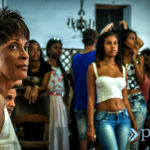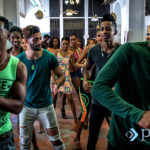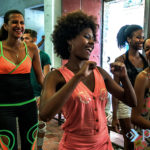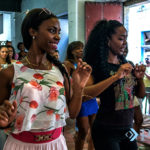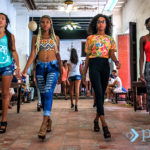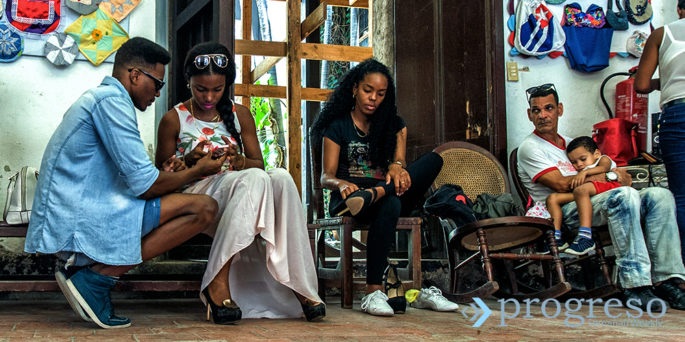
Models in Cuba: Behind the runway
HAVANA — “Plastic but natural” is how Jordana Ibáñez defines herself — and she laughs at the two adjectives, which suddenly seem compatible.
Jordana is 20 years old and studies economics at the University of Havana. She has been a model since the age of 14, dreams of becoming a Victoria’s Secret “angel” and confesses her wish like a child caught doing mischief.
Every Thursday and Saturday afternoon, she rehearses with her group at Casa Quitrín in Old Havana. Curious spectators crowd at the door, while the CD player alternates Rihanna with Justin Bieber and Maroon 5. Left-right, left-right, left, half turn, full turn. The clicking of heels follows the rhythm of the music.
A designer picks a few boys and girls for a show the following week. Jordana is among those selected, though it is likely she will not be paid for her work. Because she is 1.73 meters tall, two centimeters lower than the minimum height required, she did not meet the standards of the ACTUAR talent agency, the only one in Cuba that grants a diploma as “professional model.” Because she doesn’t have that document, she might not be able to collect payment this time.
Contrary to the “princess myth,” most of the Cuban models study or hold other jobs. “They have to do something else, because they really can’t make a living from this,” says Giselda de la Barca, a teacher and former model.
Jessica studies physical culture (she wants to be a physiotherapist) and gives modeling classes to a group of girls. Before entering the university, she was a sportswoman, a black-belt taekwondo practitioner.
Marian studies at the School of Psychology and Yoanna is a lawyer. The two participated as stewardesses in Chanel’s Havana show on May 3. Both were accepted at the casting call, along with fewer than 20 models. Yoanna arrived on the run, almost at the last moment; she had just appeared at a trial.
“When you say you’re a model, many people think that there’s nothing in your head other than clothing and shoes,” says Cindel Cuéllar, a student of pharmacy. “They tell you, ‘oh, how pretty’ but sometimes they look down on you because they think you’re foolish and are interested only in banalities.”
So, no, modeling is not a well-recognized profession for them. Not even well paid. For a night’s work, the salary could be as little as 5 convertible pesos (US$5), sometimes 10, sometimes 15.
“It depends, I did a show that paid 35 CUC per hour,” says Mayté Ortiz, a student of history. “But that was one time only, for some Mexicans who were introducing a line of clothing to Cuba.”
Whether it’s a promotion, a video clip or a television program, almost all the women agree that the work is unsteady, sporadic.
“Maybe you’re lucky and you find a designer for whom you can model regularly,” Cindel says. “Or your telephone number can get lost in the agency and they’ll never call you. I know models who graduated from ACTUAR and have never worked. If you don’t go out to look for opportunities, they won’t drop on you from the sky. You need to go looking.”
What is the right way?
Certain legends preserve their foundations. Yes, in this world sometimes you have to “act like a tiger,” there’s no dearth of “hands that rock the cradle” and Archimedes’ prescription to move the world still works.
“It’s like anything else; I’m used to it,” says Jordana, her smile fading.
Sometimes, clients have asked her to cut her hair, sometimes they’ve asked for an Afro hairdo. She says no, she likes her hair the way it is. And they haven’t selected her. In her opinion, clients generally choose more white models than black.
“In the past, when I paraded, the black models numbered two or three,” teacher De la Barca says. “But at this point the proportions are fairly equal; they all have the same opportunities.”
Cindel says that, because there are few blondes and many brown and black models, the clients select more blondes: “That depends on what the client asks for, and there’s clients of all kinds.” The client with the money is still the boss.
In the case of men, the situation is not easy, either. They get fewer jobs than the women and, perhaps for that reason, there are fewer male models. Apparently, the market “sets the trends.” On the other hand, the males can be solidly built, while the girls must be slender, no exceptions.
“When it comes to tattoos, we’ve been slightly flexible,” says Angelo Salas, an image specialist at ACTUAR. The agency allows tattoos “so long as they’re not aggressive — a U.S. flag, an imperial eagle, something that carries a socio-political message that will later look anachronistic.”
The last in line are the models from the provinces. To apply to ACTUAR, take the six-month course and get a diploma, they have to come to Havana. In other words, women living in Camagüey or Santiago de Cuba can barely harbor any hopes.
“I’m telling you,” Jordana insists, “to be a model here, you really have to like the profession.”
She hears a camera clicking and immediately turns around to look, as if someone had called out her name. Three hours later, her fuchsia-pink lipstick remains glossy. Left-right, left-right, half turn, full turn, tap, tap, tap.
The rehearsal is over, everyone applauds. Soon, the show will go on.
Photos: Carlos Ernesto Escalona Martí (Kako)



